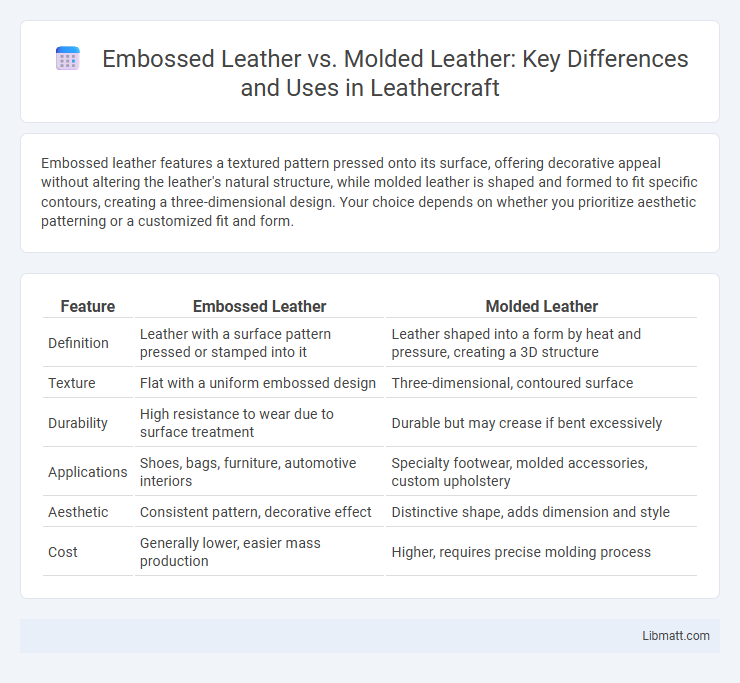Embossed leather features a textured pattern pressed onto its surface, offering decorative appeal without altering the leather's natural structure, while molded leather is shaped and formed to fit specific contours, creating a three-dimensional design. Your choice depends on whether you prioritize aesthetic patterning or a customized fit and form.
Table of Comparison
| Feature | Embossed Leather | Molded Leather |
|---|---|---|
| Definition | Leather with a surface pattern pressed or stamped into it | Leather shaped into a form by heat and pressure, creating a 3D structure |
| Texture | Flat with a uniform embossed design | Three-dimensional, contoured surface |
| Durability | High resistance to wear due to surface treatment | Durable but may crease if bent excessively |
| Applications | Shoes, bags, furniture, automotive interiors | Specialty footwear, molded accessories, custom upholstery |
| Aesthetic | Consistent pattern, decorative effect | Distinctive shape, adds dimension and style |
| Cost | Generally lower, easier mass production | Higher, requires precise molding process |
Introduction to Embossed and Molded Leather
Embossed leather features a textured pattern pressed onto the surface, replicating natural grain or unique designs for enhanced aesthetic appeal and durability. Molded leather, meanwhile, is shaped through heat and pressure into three-dimensional forms, offering custom contours ideal for specialized applications like automotive interiors or luxury accessories. Understanding the differences helps you select the right type of leather for your project based on texture, structural needs, and appearance.
Defining Embossed Leather
Embossed leather is defined by its surface texture achieved through heat and pressure, creating a raised or recessed pattern that imitates natural grain or decorative designs. Unlike molded leather, embossed leather maintains underlying leather flexibility and durability while enhancing visual appeal. Understanding the characteristics of embossed leather helps you choose the right material for stylish and long-lasting leather products.
Understanding Molded Leather
Molded leather is a type of leather shaped under heat and pressure to create three-dimensional patterns or forms without compromising its natural texture. Unlike embossed leather, which features surface patterns pressed onto a flat hide, molded leather retains its flexibility and contours to the shape, making it ideal for custom leather goods and intricate designs. The molding process enhances durability while preserving the leather's authentic feel, distinguishing it in craftsmanship and application.
Key Differences in Manufacturing Processes
Embossed leather undergoes a process where heat and pressure are applied through engraved plates to imprint patterns or textures onto the leather surface, enhancing its aesthetic appeal while retaining the hide's original traits. Molded leather, by contrast, is formed by soaking the leather to increase pliability, then shaping it into three-dimensional designs or structures using molds, resulting in a permanently contoured material. The key manufacturing difference lies in embossing's surface patterning technique versus molding's transformational shaping process.
Texture and Appearance Comparison
Embossed leather features a raised, patterned texture created by pressing heat and pressure onto the surface, giving it a consistent and decorative appearance that mimics exotic hides. Molded leather, on the other hand, is shaped while still pliable to achieve three-dimensional contours and patterns that enhance the tactile experience and add depth to the design. Understanding these differences helps you choose the right leather finish for aesthetic appeal and functional texture in your projects.
Durability and Longevity
Embossed leather features a textured surface created by pressing patterns onto genuine leather, maintaining its natural durability and aging well over time with proper care. Molded leather, shaped into specific forms during the manufacturing process, often uses softer leather or composites, which may sacrifice some durability for flexibility and design precision. Both types offer longevity, but embossed leather typically outperforms molded leather in resisting wear and retaining structural integrity.
Applications and Common Uses
Embossed leather is commonly used in fashion accessories, upholstery, and luxury handbags due to its decorative patterns that mimic exotic textures without the high cost. Molded leather finds frequent application in custom shoe manufacturing, automotive interiors, and protective gear where precise shaping and structure are essential. Both types offer durability and aesthetic appeal, but embossed leather emphasizes surface design while molded leather focuses on form and fit.
Cost and Value Differences
Embossed leather typically costs less than molded leather due to its simpler manufacturing process, involving pressing patterns onto the surface rather than shaping the leather into forms. Molded leather offers higher durability and a more refined aesthetic, resulting in greater long-term value despite its higher initial price. Consumers seeking budget-friendly options often choose embossed leather, while those prioritizing quality and longevity invest in molded leather.
Pros and Cons of Each Leather Type
Embossed leather offers a consistent texture and intricate patterns by imprinting designs onto the surface, making it durable and resistant to wear but sometimes lacking the natural feel of genuine grain. Molded leather, shaped under heat and pressure to create a three-dimensional form, provides enhanced structure and visual depth but may be less flexible and prone to cracking over time. Choosing between embossed and molded leather depends on your preference for aesthetic detail versus structural design, weighing durability against natural texture.
Choosing the Right Leather for Your Needs
Embossed leather features a stamped pattern that enhances texture and durability, making it ideal for products requiring consistent aesthetics and resistance to wear. Molded leather is shaped by heat and pressure to create three-dimensional forms, providing a tailored fit and intricate design details perfect for customized leather goods. Selecting between embossed and molded leather depends on whether your project prioritizes surface design precision or structural shaping for functional and stylistic purposes.
Embossed leather vs molded leather Infographic

 libmatt.com
libmatt.com